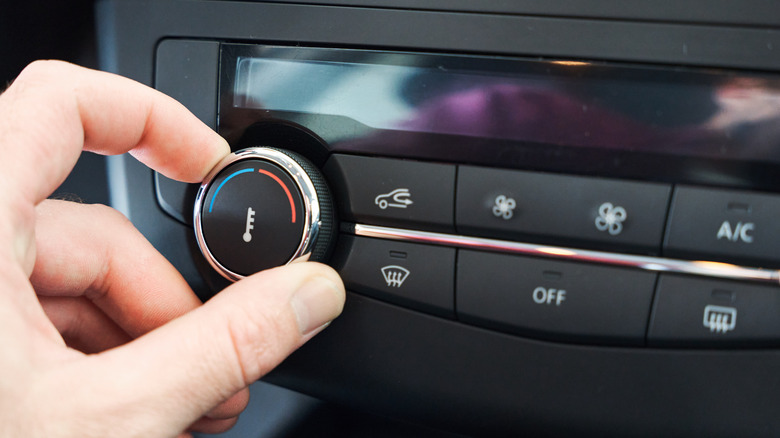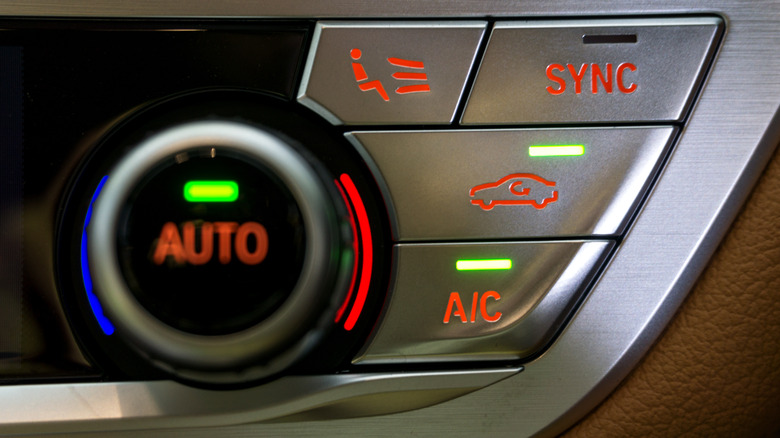What The Recirculation Button Does On Your Car (And When To Use It)
As a responsible car driver, you need to make a habit of employing basic car safety moves like wearing your seatbelt while you're inside the vehicle and using the signal to turn or switch lanes. You should also familiarize yourself with your dashboard by knowing what all the warning lights mean and what the many buttons do.
At the center portion of the dash is the center console, where you will find controls for your car's air conditioning and climate control system that allows you to control air flow in your vehicle. Some of the buttons and knobs may already be familiar to you. The A/C indicator, when lit up, means cool air will blow out from the vents. The fan icon signifies how strong you want the air blowing out of the vents to be. Auto enables automatic temperature control. So what is the car icon with the counter-clockwise circular arrow button for?
That's called the air recirculation button, and depending on when you press or activate it, it can make your time inside your vehicle a more comfortable experience. To save you the trouble of consulting your owner's manual for an in-depth explanation of what the car feature does, we'll briefly explain what air recirculation means and the most applicable times to enable or disable it in your vehicle.
What happens when the recirculation button is turned off
To understand what the air recirculation button does, it's important to understand first how climate control works inside your car. After you start your vehicle and hit the fan button on the center console, air will immediately come out of the air vent. If you want the air to blow harder, you can tweak the fan's intensity. If you're not satisfied with the coolness of the air blowing out, you can amp up the fan air by hitting the A/C button, which activates the car's air conditioning system. Simply put, this system works by pulling in air, cooling it down, and blowing it into the cabin.
At this point, you can further control where the fan air coming out of the vent is primarily sourced from: outside or inside the vehicle. That's where the recirculation button comes into play.
When the recirculation button is disabled — signified by the lack of an indicator light — fresh air is drawn in from outside the vehicle. It travels through an open air duct in the front of the car and into the car interior through the vents. When the A/C is turned on, rather than going into the car straight, it diverts outside air through the cooling system and pushes out lower temperature air into the cabin.
When it's a nice day out and it's the same temperature inside and outside the car, there's actually no need to turn A/C on — you should be fine with just the fan with recirculation turned off.
What happens when the recirculation button is turned on
On the other hand, when the recirculation button is pressed and its indicator light turns on, the air duct closes, stopping outside air from coming into the car. Instead, the fan sources air that's already within the vehicle's cabin and essentially recycles it. When the A/C is turned on in this situation, the cooling unit pulls inside air, cools it, and pushes lower temperature air back into the car.
In general, it's a good idea to enable the recirculation function on your car when outside air is hotter than the air within the cabin, or if you want to immediately cool the inside of an extremely hot or humid car down upon initial start-up of the vehicle. It's also useful for blocking smoke, dust, and outside odors from infiltrating your car interior.
Opting for recirculated air is reportedly more efficient than drawing in fresh air from outside. When it's very hot outside and you neglect to recirculate the cooler air in the car, your vehicle's AC unit is forced to draw in the hot outside air and work hard to cool it down. This may decrease your gas mileage by a small amount, as your engine has to work a bit harder to power the air conditioning unit. It also puts a bit more wear and tear on the air conditioning components as they have to run longer, and in hotter temperatures.
The best time to turn air recirculation on or off in your car
As previously mentioned, when it's cool outside, it's best to leave recirculation disabled. Leaving it on in cooler climates may potentially trap humid air within the cabin, and the higher moisture content can cause fogging on your windows, a potential driving hazard. You may also want to switch off recirculation while the outside temperature is comfortably low to have better access to fresh air and more oxygen flow. Recirculated air can turn stale and have reduced oxygen levels, making it stuffy inside the car, which in turn may make you feel groggy.
During the hot summer months, turning on both the A/C and recirculation is the quickest way to decrease the temperature in your car. It's also a must when you're driving through highly polluted areas, while stuck in traffic amid vehicles emitting fumes, or when there's ongoing construction or even a fire nearby. Finally, as mentioned, leaving recirculation off when the situation calls for it to be enabled forces your car's A/C unit to work overtime to try cooling down the hot air from outside. When the A/C system is in action, it burns fuel — the harder it works, the more fuel it burns. Air recirculation, when used properly, fosters better fuel management.
The recirculation button is a common feature in a variety of modern vehicles, although not all cars have it. If the button is missing from the center console, there are other manual ways you can facilitate better airflow in your car. For instance, you can shut all your car windows and close all the air vents to keep contaminated air from entering. You can also temporarily minimize your A/C use so you don't pull in hot air from outside.



